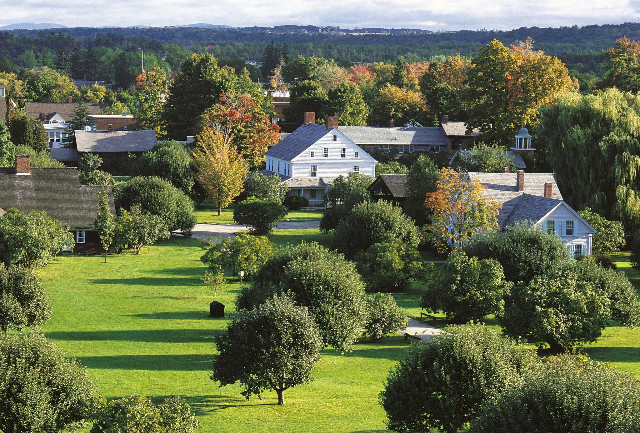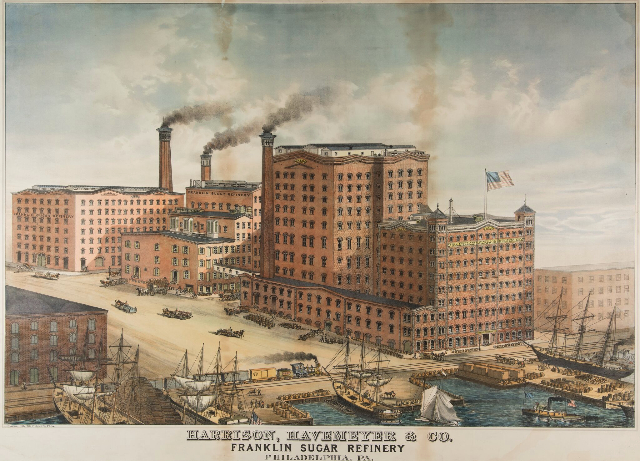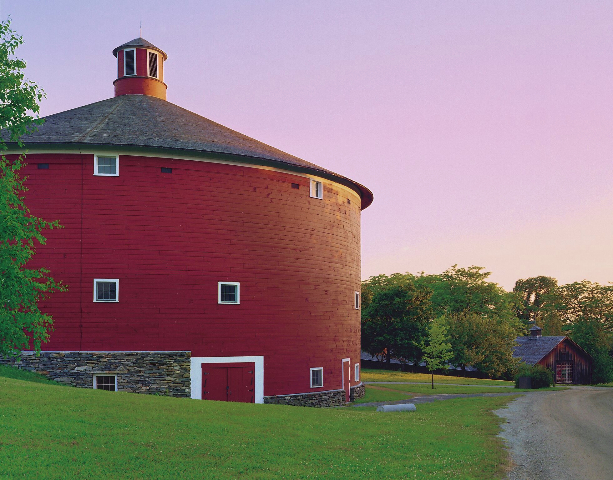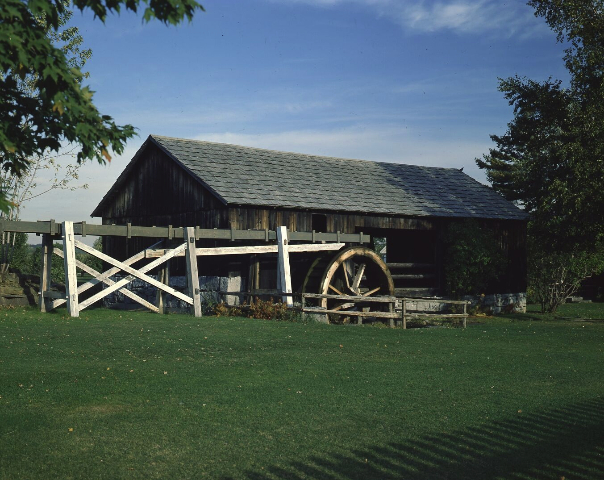Vermont’s Eclectic Shelburne Museum
How Sweet It Is
By: Charles Giuliano - Jan 12, 2018
During the gilded age of 19th century America, before the introduction of graduated income taxes in 1913, captains of industry dubbed Robber Barons, amassed vast fortunes. In pursuit of wealth they were rampant capitalists during an era when there were few if any legal or moral restraints to their tactics and greed.
In subsequent generations these ruthless families are best known for the many foundations and charities that bear their names.
Henry Osborne Havemeyer (October 18, 1847 – December 4, 1907) founded and became president of the American Sugar Refining Company in 1891. By cornering the market he became known in the media as The Sugar King. His remarkable wife Louisine proved to be a strong willed, independent and creative partner.
As a suffragette she was jailed for participating in a protest burning an effigy of President Woodrow Wilson in front of the White House. She languished in jail for three days rather than pay a $5 fine. It was a signifier of her character, conviction and defiance.
Those were qualities passed along to their daughter Electra Havemeyer Webb (August 16, 1888 – November 19, 1960) the founder of the unique, eclectic and eccentric Shelburne Museum in Vermont. She was the youngest of three siblings.
Because of the extensive travels of her parents, here and abroad, after Spence School she did not matriculate to college. One might argue that by exposure to the inner circles of fame and fortune she gained a remarkable education.
During visits to Paris, an intimate friend of her mother was the American artist Mary Cassatt. She painted a penetrating and unflattering portrait of Louisine which, with other impressionist masterpieces, are installed in the museum’s facsimile rooms which show how they were installed and lived with in the New York home of the family.
As an American aristocrat and member of the impressionist group, with a particular but complex relationship to Edgar Degas, Cassatt was a vital link to wealthy Americans on their Grand Tours. Through her connections, references and influences they collected the impressionists earlier and in greater depth than the French. Wealthy French collectors reviled their work in favor of then fashionable salon painters.
The Metropolitan Museum of Art is second only to the Musee d'Orsay in Paris in the area of 19th-century French paintings, in large part because of the Havemeyers. They donated nearly 2,000 Egyptian, Greek and Roman, Asian, Islamic and European paintings, sculptures, drawings, prints and decorative objects.
Works left to their children now hang in other museums. The National Gallery in Washington has two Goya portraits as well as Manet's "Gare St.-Lazare" and "Ball at the Opera.” The Shelburne owns Manet's electric-blue "Grand Canal, Venice." It is a particular gem as it reveals the artist moving on from the brown tones of realism to embracing the bright spectrum of light and color of his younger peers.
Electra married polo champion James Watson Webb II of the Vanderbilt family. Her parents-in-law Dr. William Seward Webb and Eliza Osgood Vanderbilt had transformed a collection of rambling lakeside farms on the shore of Vermont's Lake Champlain into a model country estate. Shelburne Farms, survives today as a nonprofit foundation dedicated to fostering innovative agricultural practices. It is a short distance from the museum campus and in season visitors can combine visits.
During a December week in Stowe we made a day trip to the museum which is just south of Burlington. It was about a 45 minute drive and proved to be a wonderful winter adventure. Now off season there are just five of thirty-nine structures open to the public on the forty-five acre campus.
It was cold and slippery so our walking tour of the campus was limited. Being a slow, midweek, off day after we visited the last open building, a display of bird decoys used for hunting, a museum security van offered us a drive back to the visitor’s center. We were grateful to accept.
This was our first visit but we are eager to return in season and fully explore the collection of period buildings from a span of centuries and genres.
The museum and its resources, among the most eccentric and intriguing in the nation, reflect what can be accomplished by a woman with little formal education, vivid imagination, personal taste and seemingly unlimited resources.
As is often the case with the super rich, enormous ego, aggressive ambition and tunnel vision taste the results can be wildly mixed. When well advised they acquired masterpieces. But the senior Havermeyer’s gifts to the Met included misattributions, forgeries, and minor works. There was indeed wheat but a lot of chaff.
The great strength of the Shelburn is its folk art collection that includes 1,400 wildfowl decoys and miniature carvings, 150 trade figures and signs, 120 weathervanes and 50 carousel figures, including all 40 animals from an early Dentzel carousel. The circus collection includes 600 historic posters, letters and memorabilia from P.T. Barnum and the hand-carved 3,500 piece Kirk Brothers Miniature Circus. The Roy Arnold Circus Parade recreates in miniature 112 attractions from the Buffalo Bill Wild West Show, Yankee Circus, and Ringling Bros. and Barnum & Bailey Circus in 525 linear feet of a special exhibition building.
Textiles include 770 bed coverings (including 500 quilts), 400 hooked and sewn rugs, early household textiles (1,800 samplers, laces and linens) and 2,800 costumes and accessories. The decorative arts collection has 6,650 pieces, including glass, ceramics, pewter, metalwork, scrimshaw and one of the country’s best regional collections of 18th- and 19th-century painted furniture. Over 1,000 dolls, 27 dollhouses and 1,200 doll accessories echo in miniature the museum’s collections of ceramics, furniture and other household furnishings. A major reinterpretation and related publication of the doll collection was completed in 2004. The collection of American and European toys dates from the beginning of the 19th century.
One has to be mega rich to “collect” architecture. The campus includes houses, barns, a meeting house, a one-room schoolhouse, a lighthouse, a jail, a general store, a covered bridge, and the 220-foot steamboat Ticonderoga. She worked with a landscape design team to situate them within a welcoming environment that today includes lush gardens and enticing views.
The works left to her by her parents are indeed astonishing. They are displayed in period rooms lacking adequate lighting. It is challenging fully to enjoy masterpieces by Cassatt, Degas, Edouard Manet, and Jean Baptiste Camille Corot. There is an odd room of her husband’s polo trophies. A basement gallery includes American West bronzes collected by her son.
The building, erected in a neo classical style with portico, is more a personal environment of her childhood than a state of the art display of iconic impressionist masterpieces. It is the strength and weakness of all such house museums including Boston’s Gardner Museum. They entice us with context of time and place.
We visited the building that houses the American collection an undertaking of her later years. As one says in the field she did not have much of an eye. Here, for example, she could have been better advised. There is a clutter of B list 19th century genre and landscape artists. Here and there one finds a gem, for example, a couple of works by Martin Johnson Heade acquired from the major Boston collector Maxim Karolik.
There are prominent names but not great works. I was confounded and amused standing before the worst painting I have ever seen by Winslow Homer. A painting by then popular Grandma Moses is indicative of the paradigms of taste when she was acquiring Americana.
In founding such a sprawling and eclectic museum, with so many objects to conserve and maintain, one inevitably speculates on the depth of financial resources. Moving forward from its founders museums are living organisms reliant on endowments.
Currently, we await the appellate court ruling regarding the attempt of the Berkshire Museum to sell 40 masterpieces to finance brick and mortar expansion and bolster its endowment.
In 1996, the Shelburne Museum sold $30 million of its art to pay expenses. J. Watson Webb, Jr. the son of Electra Havemeyer Webb, resigned in protest. He believed that the sale violated the code of ethics of the American Alliance of Museums, which forbids the selling of artworks for purposes other than acquiring more art. The funds from the sale were used to establish a Collections Care Endowment which is used to support the ongoing remedial and preventative conservation, storage and management of the Museum's collection. This use of funds conforms to AAM guidelines.
In 2013, the Pizzagalli Center for Art and Education was opened with two galleries, an auditorium and classroom, transforming the institution from seasonal (mid-May through October) to year-round operation. While the main campus operates seasonally, the Pizzagalli Center and Museum Store are open year-round.
It is unclear what part of the $30 million deaccession went to fund the new building which is located next to the visitor’s center at the head of the campus. Without question it is an invaluable asset with handsome special exhibition galleries. This is particularly crucial in providing a year-round presence for the museum.
During our visit we much enjoyed two special exhibitions “Sweet Tooth: The Art of Dessert” (through February 18) and “Hooked on Patty Yoder” which closes soon on January 21.
The Sweet Tooth exhibition was indeed a delicious experience. It took the entire range of the Havermeyer’s Sugar King legacy to a fresh, lively, raucous new dimension. The show has been brilliantly curated (but unaccredited in the museum handouts). A great range of confection based work by artists I was unfamiliar with has been assembled to create an array of amazing eye candy.
Visitors will need a shot of insulin after imbibing this rush of visual experience.
You may also get hooked on the craft based portrait and figure “paintings” by Yoder. In a clever approach yarn is treated as color creating rough tapestries. In studies and half completed works one is informed of the process of the artist.
It is such lively changing special exhibitions that make the Shelburne a lure for repeated excursions to enjoy the four seasons of bucolic Vermont.







